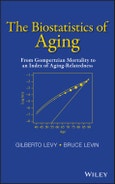A practical and clarifying approach to aging and aging-related diseases
Providing a thorough and extensive theoretical framework, The Biostatistics of Aging: From Gompertzian Mortality to an Index of Aging-Relatedness addresses the surprisingly subtlenotion - with consequential biomedical and public health relevance - of what it means for acondition to be related to aging. In this pursuit, the book presents a new quantitative methodto examine the relative contributions of genetic and environmental factors to mortality anddisease incidence in a population.
With input from evolutionary biology, population genetics, demography, and epidemiology, this medically motivated book describes an index of aging-relatedness and also features:
- Original results on the asymptotic behavior of the minimum of time-to-event random variables, which extends those of the classical statistical theory of extreme values
- A comprehensive and satisfactory explanation based on biological principles of the Gompertz pattern of mortality in human populations
- The development of an evolution-based model of causation relevant to mortality and aging-related diseases of complex etiology
- An explanation of how and why the description of human mortality by the Gompertz distribution can be improved upon from first principles
- The amply illustrated analysis of real-world data, including a program for conducting the analysis written in the freely available R statistical software
- Technical appendices including mathematical material as well as an extensive and multidisciplinary bibliography on aging and aging-related diseases
The Biostatistics of Aging: From Gompertzian Mortality to an Index of Aging-Relatedness is an excellent resource for practitioners and researchers with an interest in aging and aging-related diseases from the fields of medicine, biology, gerontology, biostatistics, epidemiology, demography, and public health.
Table of Contents
PREFACE AND ACKNOWLEDGMENT ix
1 Introduction 1
2 An Account of Gompertzian Mortality through Statistical and Evolutionary Arguments 6
2.1 The Statistical Theory of Extreme Values 10
2.2 The Evolutionary Theory of Aging 36
3 The Argument against Gompertzian Mortality 69
3.1 Departures from the Gompertz Model 70
3.2 An Evolution-Based Model of Causation 72
4 The Index of Aging-Relatedness 93
4.1 A Survival Mixture Model of the Gompertz and Weibull Distributions 94
4.2 Definition and Interpretation of the Index of Aging-Relatedness 97
4.3 The Survival Mixture Model and Competing Risks 103
4.4 Estimation of the Model Parameters 107
4.5 Illustrative Application: The Israeli Ischemic Heart Disease Study 109
4.6 Precision of Estimation 122
5 Discussion: Implications 128
5.1 The Meaning of the Gompertz Parameter 128
5.2 Age as a Risk Factor for Disease 132
5.3 Are Aging-Related Diseases an Integral Part of Aging? 134
5.4 Biological versus Chronological Aging 135
5.5 The Public Health Notion of Compression of Morbidity 138
5.6 A Picture of Aging for the Twenty-First Century 143
APPENDIX A: PROOFS OF RESULTS IN SECTION 2.1.2 WITH SOME EXTENSIONS 154
APPENDIX B: DERIVATION OF HAMILTON’S EQUATION FOR THE FORCE OF NATURAL SELECTION ON MORTALITY 170
APPENDIX C: SOME PROPERTIES OF THE GOMPERTZ AND WEIBULL DISTRIBUTIONS 174
APPENDIX D: FIRST AND SECOND PARTIAL DERIVATIVES OF THE MIXTURE LOG-LIKELIHOOD FUNCTION 178
APPENDIX E: EXPECTATION–CONDITIONAL MAXIMIZATION (ECM) ALGORITHM 183
APPENDIX F: R PROGRAM 190
REFERENCES 226
AUTHOR INDEX 245
SUBJECT INDEX 253








